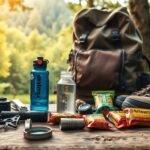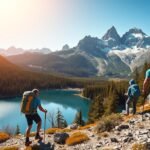Now Reading: The Ultimate Packing List for Outdoor Enthusiasts
-
01
The Ultimate Packing List for Outdoor Enthusiasts
The Ultimate Packing List for Outdoor Enthusiasts

The Ultimate Packing List for Outdoor Enthusiasts
For outdoor lovers, the right gear is crucial. It can turn a good trip into an amazing one. Being prepared is essential for enjoying the outdoors, whether hiking, camping, or other activities.

A good packing list ensures you have everything you need. This article will help you create the perfect packing list for your outdoor adventures. It covers the basics for various activities and hobbies.
Key Takeaways
- A curated checklist of outdoor essentials tailored to different hobbies and activities.
- Tips for creating a personalized packing list based on your specific outdoor plans.
- An overview of the most critical items to include in your outdoor packing list.
- Guidance on how to prepare for varying weather conditions and environments.
- Strategies for packing efficiently and effectively for outdoor adventures.
The Fundamentals of Smart Outdoor Packing
Effective outdoor packing is a mix of preparation, knowledge, and the right gear. It’s about being ready for surprises without carrying too much.
Why Proper Preparation Matters
Being well-prepared is key to a great outdoor adventure. You need to know the terrain, weather, and activities. This helps pick the must-have items for outdoor adventures you’ll really need.
The Philosophy of Packing Light but Smart
Packing light is a big deal for outdoor lovers. It’s not just about less weight; it’s about the right gear for the job. You need to choose wisely for your outdoor gear checklist.
Weight vs. Functionality Balance
Finding the right balance between weight and usefulness is important. It’s tempting to choose the lightest gear, but it must also work well. For example, a multi-tool is often better than a single-use tool, even if it’s heavier.
Multi-Purpose Gear Selection
Choosing gear that does more than one thing is smart packing. A sarong, for example, can be a blanket, towel, or picnic mat. Always aim for light but smart packing. Focus on gear with many uses and invest in quality over quantity.
Get Outside What to Bring: Core Principles
Packing for outdoor trips needs careful thought to stay safe and have fun. Knowing the basics of what to pack is key for any outdoor lover.
The Ten Essentials Philosophy
The Ten Essentials Philosophy is a well-known guide for outdoor prep. It stresses the need to carry ten key items for safety and preparedness in different outdoor settings. These include navigation tools, sun protection, insulation, light sources, first aid, fire starters, repair kits, food, water, and emergency shelter.
Adapting Your Gear to Your Specific Activity
Different outdoor activities need specific gear. For example, hikers need strong shoes and trekking poles, while campers need good shelter and sleeping bags. Knowing what your activity demands helps you tailor your packing list to fit those needs well.
Risk Assessment and Gear Selection
Doing a detailed risk assessment is key to picking the right gear. This means looking at possible dangers from your activity and surroundings. Then, choose equipment that lessens those risks. The right gear makes your outdoor adventure safer and more enjoyable.
Weather Considerations for Your Packing List
Packing for the outdoors is more than just about the gear. It’s also about knowing the weather. Outdoor lovers need to think about the weather to be ready.
Seasonal Packing Adjustments
Different seasons mean different packing needs. For example, summer excursions need light, breathable clothes and sun protection. On the other hand, winter trips require warm, layered clothes and gear for snow and ice.
Summer Heat Strategies
In summer, pack clothes that let air in and wick away moisture. Remember to include sunscreen, a hat, and sunglasses in your outdoor supplies packing guide.
Winter Cold Management
For winter, focus on layered clothes that keep you warm. Include insulated jackets, warm hats, and gloves. Think about your activities and pack what you need.
Preparing for Unexpected Weather Changes
Weather can change fast. It’s key to be ready for surprises by packing versatile gear. A waterproof jacket, for instance, can save you from sudden rain.
| Weather Condition | Essential Items |
|---|---|
| Summer Heat | Lightweight clothing, sunscreen, hat, sunglasses |
| Winter Cold | Insulated clothing, warm hat, gloves, waterproof boots |
| Rain | Waterproof jacket, rain pants, extra socks |
Think about the weather and adjust your packing list. This way, you’ll have a safer and more fun outdoor time. Always check the forecast and be ready for anything.
Clothing and Layering Systems
Layering clothes is an art that makes outdoor activities better. It’s about picking the right clothes to handle moisture, keep warm, and shield from the weather.
Base Layers: Managing Moisture
Base layers are key for keeping dry. They should be made of materials that pull sweat away, like merino wool or synthetic fabrics. Moisture-wicking base layers keep your skin dry and comfy.
Mid Layers: Insulation Strategies
Mid layers keep you warm and can change with your activity and the weather. Fleece jackets and insulated jackets are popular choices. They trap warm air to keep your body heat in.
Outer Layers: Protection from Elements
Outer layers shield you from wind, rain, and snow. They need to be both waterproof and let air through.
Waterproof Options
Look for jackets with a waterproof and breathable membrane, like Gore-Tex. These keep you dry in rain and wind.
Wind Protection
Windproof layers are vital in cold, windy weather. Softshell jackets or windbreakers are great for blocking wind.
When making a packing list for outdoor activities, think about layering. A good outdoor gear checklist should have clothes that can be layered for different weather.
- Choose base layers that manage moisture effectively.
- Select mid layers that provide adequate insulation.
- Opt for outer layers that are both waterproof and breathable.
Footwear and Foot Care Essentials
Footwear is key for enjoying outdoor activities. The right shoes can make a big difference in how well you perform and feel. It’s important to pick the right ones.
Selecting the Right Shoes for Your Activity
What shoes you need depends on the activity. Hiking boots are great for rough trails, while trail running shoes work better on smooth paths. Choosing the right shoes is vital for comfort and safety.
Socks and Blister Prevention
Good socks are also crucial. Moisture-wicking socks, like those made from merino wool or synthetic fibers, keep your feet dry. They also reduce friction. Adding these to your outdoor equipment essentials can make a big difference.
Foot Care Kit Components
A foot care kit is a must-have item for outdoor adventures. It should have blister care, foot powder, and any personal foot care items. Having a kit ready can help solve problems quickly and prevent them from getting worse.
Hydration and Water Management
Staying hydrated is crucial for a great outdoor trip. It’s important to know how much water you need. Outdoor lovers must think about several things to keep drinking water.
Water Containers and Filtration Systems
Picking the right water gear is key. Collapsible water bottles and hydration bladders are great for carrying water. Water filters and purification tablets help make sure the water is safe to drink.

Calculating Your Water Needs by Activity
How much water you need depends on what you’re doing, where you are, and who you are. A good starting point is to carry at least one liter of water per person per hour of moderate activity in mild weather. You might need more in very hot or cold places or if you’re doing something very active.
| Activity Level | Water Needs per Hour |
|---|---|
| Low | 0.5 liters |
| Moderate | 1 liter |
| High | 1.5 liters |
Emergency Water Solutions
In emergencies, having the right tools can save lives. Water purification tablets and portable filters are must-haves for your outdoor kit. Learning how to find and clean water from nature is also very useful.
By knowing how to manage water and stay hydrated, outdoor fans can have a safer and more fun time on their trips.
Nutrition and Food Planning
Outdoor lovers know that good food is key to a great adventure. Eating right keeps you energized, safe, and happy. It makes every outdoor moment better.
Energy-Dense Food Options
Choosing the right foods for outdoor trips is important. Look for foods that are full of energy but light and easy to make. Nuts, dried fruits, jerky, and whole-grain crackers are great choices. They give you the calories you need without weighing you down.
Nutrient-dense options like trail mix are full of energy and vitamins. They’re perfect for keeping you going on your adventures.
Meal Planning for Different Trip Lengths
Planning your meals is a big part of getting ready for an outdoor trip. For short trips, simple snacks are enough. But for longer trips, you’ll need to plan meals for breakfast, lunch, dinner, and snacks. Use meal planning apps or guides to help plan based on your trip’s length and how many people are going.
Food Storage and Preparation Tools
Keeping food safe and away from wildlife is crucial. Use airtight containers and keep food in a safe spot away from your campsite. For cooking, choose lightweight gear like portable stoves or camping grills.
Cooking Equipment Essentials
Good cooking gear should be light, strong, and easy to use. You’ll need a portable stove, cooking pot, and utensils. Don’t forget stove fuel and a way to light it.
Leave No Trace Food Practices
Follow Leave No Trace when you’re outdoors. This means disposing of food waste and packaging properly. Take all trash and leftovers with you and avoid leaving food or scented items behind.
| Food Type | Examples | Benefits |
|---|---|---|
| Energy Bars | Clif Bars, PowerBars | Convenient, high in calories |
| Dried Fruits | Apricots, Apples | Rich in fiber, vitamins |
| Nuts and Seeds | Almonds, Sunflower Seeds | High in protein, healthy fats |
Good planning of your food and storage ensures a fun and safe outdoor trip. Always remember to take out what you bring in and leave your campsite as you found it.
Essential Tools and Multi-Purpose Equipment
The great outdoors demands preparation, and that includes packing essential tools. When venturing into nature, having the right equipment can make a significant difference in the success and enjoyment of your adventure.
Knives and Multi-Tools
A good knife is an indispensable tool for any outdoor enthusiast. It can be used for a variety of tasks, from cutting branches to preparing food. A multi-tool takes this versatility a step further, offering a range of functions such as pliers, scissors, and screwdrivers, all in one compact device.
Repair Kits for Common Gear
Gear failure can happen at any time, and being prepared with a repair kit can save the day. These kits usually include items like duct tape, cordage, and patches for fixing tents and clothing. Knowing how to make basic repairs can keep you going until you can get back to civilization.
Lighting Solutions
Lighting is crucial for navigating and setting up camp in the dark. There are several options available, including headlamps and flashlights.
Headlamps and Flashlights
Headlamps are particularly useful as they allow for hands-free operation, making tasks like cooking or setting up a tent much easier. Flashlights, on the other hand, can be more powerful and are often used for illuminating larger areas.
Emergency Light Sources
In addition to primary lighting sources, it’s wise to carry emergency light sources like glow sticks or extra batteries. These can be lifesavers if your primary light source fails.
By including these essential tools and multi-purpose equipment in your outdoor gear checklist, you’ll be better prepared to handle the challenges that come with exploring the great outdoors.

Navigation and Communication Tools
When you go outside, having the right tools is key. These tools help you find your way and call for help if needed.
Maps and Compasses
A map and compass are basic but crucial. They’re still important, even with today’s tech. Learning to use them well is essential.
- Choose maps that are detailed and updated regularly.
- Understand how to use a compass to determine directions.
GPS Devices and Smartphone Apps
GPS devices and apps have changed how we navigate. They give exact locations and track paths. Some popular ones are:
- Garmin GPS devices for detailed topographic information.
- Apps like Gaia GPS and AllTrails for route tracking and discovery.
Emergency Communication Devices
In emergencies, being able to communicate is vital. There are several options:
Personal Locator Beacons
PLBs send a distress signal to emergency responders. They’re great in areas without cell service.
Satellite Messengers
Satellite messengers let you send and receive messages without cell service. The Garmin inReach is a favorite among outdoor lovers.
Using both old and new tools makes outdoor adventures safer and more fun.
Essential Items to Pack for Outdoor Adventures
When venturing into the great outdoors, it’s crucial to pack the right gear to ensure a safe and enjoyable experience. Here are some must-have items to include in your outdoor adventure checklist:
1. Navigation Tools
Having reliable navigation tools is essential for any outdoor adventure. This includes a map, compass, and GPS device. These tools will help you stay on track and find your way back to camp or civilization.
2. First Aid Kit
A well-stocked first aid kit is a vital item to include in your outdoor adventure checklist. It should contain essentials such as bandages, antiseptic wipes, pain relievers, and any medications you may need. Accidents can happen, and having a first aid kit on hand can help you treat minor injuries and prevent more serious ones.
3. Shelter and Sleeping Gear
Depending on the length and type of your outdoor adventure, you may need to bring a tent, sleeping bag, and sleeping pad. These items will provide you with a comfortable place to rest and protect you from the elements.
4. Clothing and Layers
Packing the right clothing and layers is crucial for outdoor adventures. Include a base layer for colder weather, insulating layers for warmth, and a waterproof jacket or poncho to keep you dry. Don’t forget to include warm socks, gloves, and a hat to stay comfortable in changing weather conditions.
5. Hydration and Nutrition
Staying hydrated and fueled is essential for outdoor adventures. Bring a water bottle or hydration pack to ensure you have enough water throughout the day. Pack non-perishable snacks and energy-rich foods to keep your energy levels up. Don’t forget to include a water purification system or filter if you plan to drink water from natural sources.
6. Fire Starters
Fire can be a lifesaver in outdoor adventures. Bring a lighter or waterproof matches to start a campfire for warmth, cooking, and signaling for help if needed. Make sure to follow any local fire restrictions and fully extinguish the fire before leaving it unattended.
7. Personal Hygiene Items
While it may not be the most glamorous item on your outdoor adventure checklist, personal hygiene items are important for maintaining cleanliness and preventing the spread of illness. Include hand sanitizer, biodegradable soap, toothbrush and toothpaste, and any other essential hygiene items you may need.
8. Safety Equipment
Depending on the nature of your outdoor adventure, you may need to bring safety equipment such as bear spray, a whistle, or a personal locator beacon (PLB). These items can help protect you from wildlife encounters and ensure you can signal for help in case of an emergency.
9. Trash Bags and a Portable Stove
When camping or backpacking, it’s important to leave no trace behind. Bring trash bags to collect and dispose of your waste properly. If you plan to cook meals, a portable stove is a convenient and efficient way to prepare food without relying on campfires.
10. Emergency Supplies
It’s always better to be prepared for emergencies. Include items such as a spare set of clothes, a warm blanket, a basic toolkit, and a first aid manual in your outdoor adventure checklist. These supplies can help you stay safe and comfortable in unexpected situations.
By packing these essential items, you’ll be well-prepared for your outdoor adventures and can focus on enjoying the beauty of nature. Remember to check the weather forecast and adjust your packing list accordingly to ensure you have everything you need for a safe and enjoyable trip.
Activity-Specific Packing Lists
## Activity-Specific Packing Lists
### Day Hiking Essentials
When you’re going on a day hike, it’s key to pack the right stuff. This ensures a safe and fun trip. Here’s what you should bring:
* Navigation tools: map, compass, and GPS device
* First aid kit: bandages, antiseptic wipes, pain relievers, and any personal medications
* Hydration: water bottle or hydration bladder, and water purification tablets or filter
* Snacks: energy-rich foods like nuts, dried fruits, and jerky
* Extra clothing: layers for changing weather, including a base layer, insulating layer, and waterproof jacket
* Headlamp or flashlight and extra batteries
* Fire starter: matches, lighter, and kindling
* Emergency shelter: lightweight tent, sleeping bag, and sleeping pad
* Personal hygiene items: hand sanitizer, toilet paper, and biodegradable soap
### Overnight Backpacking Gear
For overnight trips, add these to your list:
* Sleeping bag and pad
* Backpack with rain cover
* Camping stove and fuel
* Cooking pot and utensils
* Food storage containers
* Water treatment: water purification tablets or filter
* Personal hygiene items: biodegradable soap, toilet paper, and hand sanitizer
### Family Picnicking Supplies
For a family picnic, pack these essentials:
* Blanket or picnic mat
* Cooler with ice packs
* Refreshments: beverages, sandwiches, fruits, and snacks
* Utensils: plates, cups, and cutlery
* Napkins and paper towels
### Mountain Biking Equipment
Don’t forget these for mountain biking:
* Helmet
* Gloves
* Water bottle or hydration pack
* Basic tool kit: tire levers, pump, and multi-tool
* First aid kit: basic first aid supplies
### Water Activities Gear
For water activities like kayaking, canoeing, or swimming, consider these:
#### Kayaking and Canoeing
* Kayak or canoe
* Paddle
* Personal flotation device (PFD)
* Safety whistle
* Dry bag or waterproof container for storing gear
#### Swimming and Beach Days
* Swimwear
* Towel
* Sunscreen and sun hat
* Beach umbrella or canopy (optional)
* Water shoes or sandals
* Snorkeling gear (mask, snorkel, and fins) or swimming goggles (if applicable)
By using these activity-specific lists, you’ll be ready for your outdoor adventure. You’ll have a safe and fun time.
Conclusion: Embracing the Outdoors with Confidence
## Conclusion: Embracing the Outdoors with Confidence
This guide to outdoor packing has covered a lot. It’s key to remember the main points for your outdoor adventures. By following the advice, you’ll be ready for any outdoor activity.
Having a good packing list is vital for a great outdoor trip. We’ve talked about weather, gear for your activity, and keeping clean. These tips will help you prepare for outdoor challenges.
Before your next adventure, check the weather and pack accordingly. Remember to bring a first-aid kit, a map, and a way to communicate. Being ready ensures a safe and fun time outdoors. With the right gear, you’ll enjoy the outdoors fully and make memories.
Follow this article’s advice and pay attention to your packing list. You’ll be ready to enjoy the outdoors confidently. Happy adventuring!
## FAQ
### Q: What are the most essential items to include in an outdoor packing list?
### A:
Include items that fit your outdoor activity, the environment, and personal needs. This means clothing, footwear, hydration, nutrition, first aid, navigation tools, and shelter.
### Q: How do I determine the right clothing for my outdoor activity?
### A:
Think about the activity, weather, and layering. You’ll need base, mid, and outer layers for comfort.
### Q: What are the key considerations for footwear selection?
### A:
Choose shoes that match your activity, offer support, and protect your feet from the environment and terrain.
### Q: How can I ensure I stay hydrated during my outdoor adventure?
### A:
Bring enough water and consider a water filter. Also, have a backup plan for water purification or emergency hydration.
### Q: What are the essential nutrition and food planning considerations?
### A:
Plan meals based on trip length, activity level, and dietary needs. Pack energy-rich foods, cooking gear, and containers for food storage.
### Q: What are the must-have tools for outdoor adventures?
### A:
Carry a multi-tool or pocket knife, a repair kit, and a light source like a headlamp or flashlight.
### Q: How can I effectively navigate during my outdoor trip?
### A:
Bring a map, compass, and a GPS device or app. Also, have a personal locator beacon (PLB) or satellite messenger for emergencies.
### Q: What first aid and emergency preparedness measures should I take?
### A:
Make a detailed first aid kit and include specific medical supplies for your activity. Be ready for emergencies with a survival blanket, bivvy sack, or other shelter options.
### Q: Are there any specific packing lists for different outdoor activities?
### A:
Yes, adjust your list for activities like day hiking, backpacking, picnicking, biking, or water sports like kayaking or swimming.
### Q: How can I be better prepared for my outdoor adventure?
### A:
By considering the various aspects mentioned and tailoring your list, you can have a well-prepared and enjoyable outdoor experience.






























